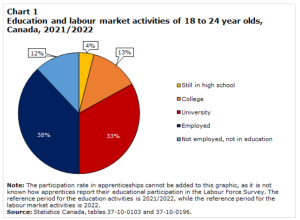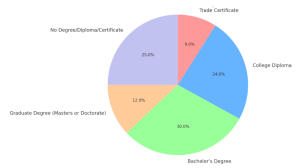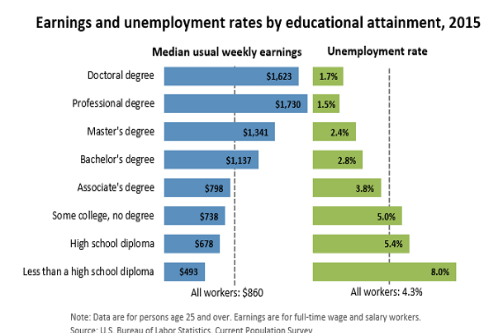106
According to a 2023 report by Statistics Canada, the 202—2021 school year saw approximately 350,0000 young Canadian adults graduating from high school programs, 24,000 graduating from various vocational programs, and 9000 graduating from adult focused general education programs (Zema, K, 2023)
Zema, K. (2023). From high school, into postsecondary education and on to the labour market: Education, learning and training: Research Paper Series. Stats Canada.
In 2020/2021, approximately 354,000 young Canadians graduated from regular high school programs, with an additional 24,000 graduating from vocational programs and 9,000 from adult general programs (Statistics Canada, 2023). The high school graduation rate reached 84% in 2019/2020, an increase from 81% in 2018/2019, with girls graduating at a higher rate (87%) than boys (81%) (Statistics Canada, 2023). Extending the timeframe to five years after starting grade 10 (or secondary 3 in Quebec), the graduation rate increased to 89%, with 91% of girls and 86% of boys completing high school (Statistics Canada, 2023). In 2021/2022, 50% of 18- to 24-year-olds participated in some form of education, with 33% enrolled in universities and 13% in colleges (Statistics Canada, 2023). About 3% of this age group were registered apprentices, with 101,727 apprentices in total (Statistics Canada, 2023). Postsecondary students showed high persistence rates, with 90% of undergraduates persisting after one year, and 74% graduating within six years, with an average completion time of 4.24 years (Statistics Canada, 2023). For career or technical programs, only 57% of students graduated within four years, while for apprenticeships, 21% certified on time, increasing to 34% within 1.5 times the program duration, with a median certification time of 3.2 years (Statistics Canada, 2023). By 2021, 75% of Canadians aged 25 to 34 had attained a postsecondary qualification, with 30% holding a bachelor’s degree, 24% a college diploma, and 9% a trade certificate (Statistics Canada, 2023). Labour market outcomes revealed that two years post-graduation, university graduates earned a median income of $50,900, compared to $39,700 for college diploma holders, and $59,000 for certified apprentices (Statistics Canada, 2023). Additionally, unemployment rates were lower for individuals with higher educational attainment, especially during economic downturns like the COVID-19 pandemic (Statistics Canada, 2023).
References
Statistics Canada. (2023, July 28). From high school, into postsecondary education and on to the labour market. https://www150.statcan.gc.ca/n1/pub/81-595-m/81-595-m2023004-eng.htm

Chart depicting number of secondary schools graduates by school type and program type.
Canada has a relatively high proportion of young people completing high school studies within the expected time-period – within 3 years of the start of 10th grade (in Quebec, of the start of ‘Secondary 3’) or around 18 years of age (Zema, K, 2023).
After receipt of high school diploma young adults generally begin post-secondary education of one form or another or they enter into labour market (often – to make ends meet these days – they do both). During 2021-22, amongst 18 – 24 year-olds, there is an even split (50% / 50%) between those pursuing education and those not currently enrolled (Zema, K, 2023).
As indicated in the chart below:
- Of the 50% pursing education 4% were working on a high school diploma, 13% were enrolled in college, and 33% in university.
- Of the other 50% of 18 – 24 year-olds – those not pursuing education in 2021-2022 – 38% were employed and 12% were not employed or enrolled in education or training programs.


Educational Attainment:
Post-secondary education may be undertaken in any period of the lifespan. In 2021, Canadians in early / middle adulthood (here: 25 to 35 years old) the rates of educational attainment are as follows (Zema, K, 2023).

Is college worth the time and investment? College is certainly a substantial investment each year, with the financial burden falling on students and their families in the U.S., and mainly by the government in many other nations. Nonetheless, the benefits both to the individual and the society outweighs the initial costs. As can be seen in Figure 7.16, those in America with the most advanced degrees earn the highest income and have the lowest unemployment.

Worldwide, over 80% of college educated adults are employed, compared with just over 70% of those with a high school or equivalent diploma, and only 60% of those with no high school diploma (OECD, 2015). Those with a college degree will earn more over the course of their life time. Moreover, the benefits of college education go beyond employment and finances. The OECD found that around the world, adults with higher educational attainment were more likely to volunteer, felt they had more control over their lives, and thus were more interested in the world around them. Studies of U.S. college students find that they gain a more distinct identity and become more socially competent, less dogmatic and ethnocentric compared to those not in college (Pascarella, 2006).
Career Development and Employment
Work plays a significant role in the lives of people, and emerging and early adulthood is the time when most of us make choices that will establish our careers. Career development has a number of stages:
- Stage One: As children we may select careers based on what appears glamorous or exciting to us (Patton & McMahon, 1999). There is little regard in this stage for whether we are suited for our occupational choices.
- Stage Two: In the second stage, teens include their abilities and limitations, in addition to the glamour of the occupation when narrowing their choices.
- Stage Three: Older teens and emerging adults narrow their choices further and begin to weigh more objectively the requirements, rewards, and downsides to careers, along with comparing possible careers with their own interests, values, and future goals (Patton & McMahon, 1999). However, some young people in this stage “fall-into” careers simply because these were what were available at the time, because of family pressures to pursue particular paths, or because these were high paying jobs, rather than from an intrinsic interest in that career path (Patton & McMahon, 1999).
- Stage Four: Super (1980) suggests that by our mid to late thirties, many adults settle in their careers. Even though they might change companies or move up in their position, there is a sense of continuity and forward motion in their career. However, some people at this point in their working life may feel trapped, especially if there is little opportunity for advancement in a more dead-end job.
What role does gender play on career and employment? Gender also has an impact on career choices. Despite the rise in the number of women who work outside of the home, there are some career fields that are still pursued more by men than women. Jobs held by women still tend to cluster in the service sector, such as education, nursing, and child-care worker. While in more technical and scientific careers, women are greatly outnumbered by men. Jobs that have been traditionally held by women tend to have lower status, pay, benefits, and job security (Ceci & Williams, 2007).
In recent years, women have made inroads into fields once dominated by males, and today women are almost as likely as men to become medical doctors or lawyers. Despite these changes, women are more likely to have lower-status, and thus less pay than men in these professions. For instance, women are more likely to be a family practice doctor than a surgeon, or are less likely to make partner in a law firm (Ceci & Williams, 2007).
Real Life: Jobs and Careers
Have you ever wondered if it was possible to truly love what you do to earn a living? It is possible, according to Scott Dinsmore. Find out Dinsmore’s recipe for how to find meaningful work that will bring you joy by watching the following TED Talk
As you engage in the job search, you might find it useful to seek answers to the following guiding questions:
- What profession am I best suited for? If you like, test yourself using the governmental job bank’s handy Career Navigator.
- What incomes are standard for each industry? To learn more, feel free to check out Statistics Canada’s Average weekly earnings by industry, annual.
- What is the outlook for my prospective career? Discover your career’s future prospects by visiting the Canadian Occupational Projection System‘s page.
Richard N. Bolles’s engaging book What Color is Your Parachute? claims to be the world’s most popular guide to job searching. If you like, pick up a copy and see if it helps you.
Sexism
Sexism or gender discrimination is prejudice or discrimination based on a person’s sex or gender. Sexism can affect any sex that is marginalized or oppressed in a society; however, it is particularly documented as affecting females. It has been linked to stereotypes and gender roles and includes the belief that males are intrinsically superior to other sexes and genders. Extreme sexism may foster sexual harassment, rape, and other forms of sexual violence.
Sexism can exist on a societal level, such as in hiring, employment opportunities, and education. In the United States, women are less likely to be hired or promoted in male-dominated professions, such as engineering, aviation, and construction (Blau, Ferber, & Winkler, 2010; Ceci & Williams, 2011). In many areas of the world, young girls are not given the same access to nutrition, healthcare, and education as boys. Sexism also includes people’s expectations of how members of a gender group should behave. For example, women are expected to be friendly, passive, and nurturing; when a woman behaves in an unfriendly or assertive manner, she may be disliked or perceived as aggressive because she has violated a gender role (Rudman, 1998). In contrast, a man behaving in a similarly unfriendly or assertive way might be perceived as strong or even gain respect in some circumstances.

Occupational sexism involves discriminatory practices, statements, or actions, based on a person’s sex, that occur in the workplace. One form of occupational sexism is wage discrimination. In 2008, the Organisation for Economic Co-operation and Development (OECD) found that while female employment rates have expanded, and gender employment and wage gaps have narrowed nearly everywhere, on average women still have a 20 percent less chance to have a job. The Council of Economic Advisors (2015) found that despite women holding 49.3% of the jobs, they are paid only 78 cents for every $1.00 a man earns. It also found that despite the fact that many countries, including the U.S., have established anti-discrimination laws, these laws are difficult to enforce. In the United States, women account for 47% of the overall labor force, yet they make up only 6 percent of corporate CEOs and top executives. Some researchers see the root cause of this situation in the tacit discrimination based on gender, conducted by current top executives and corporate directors (who are primarily male).

